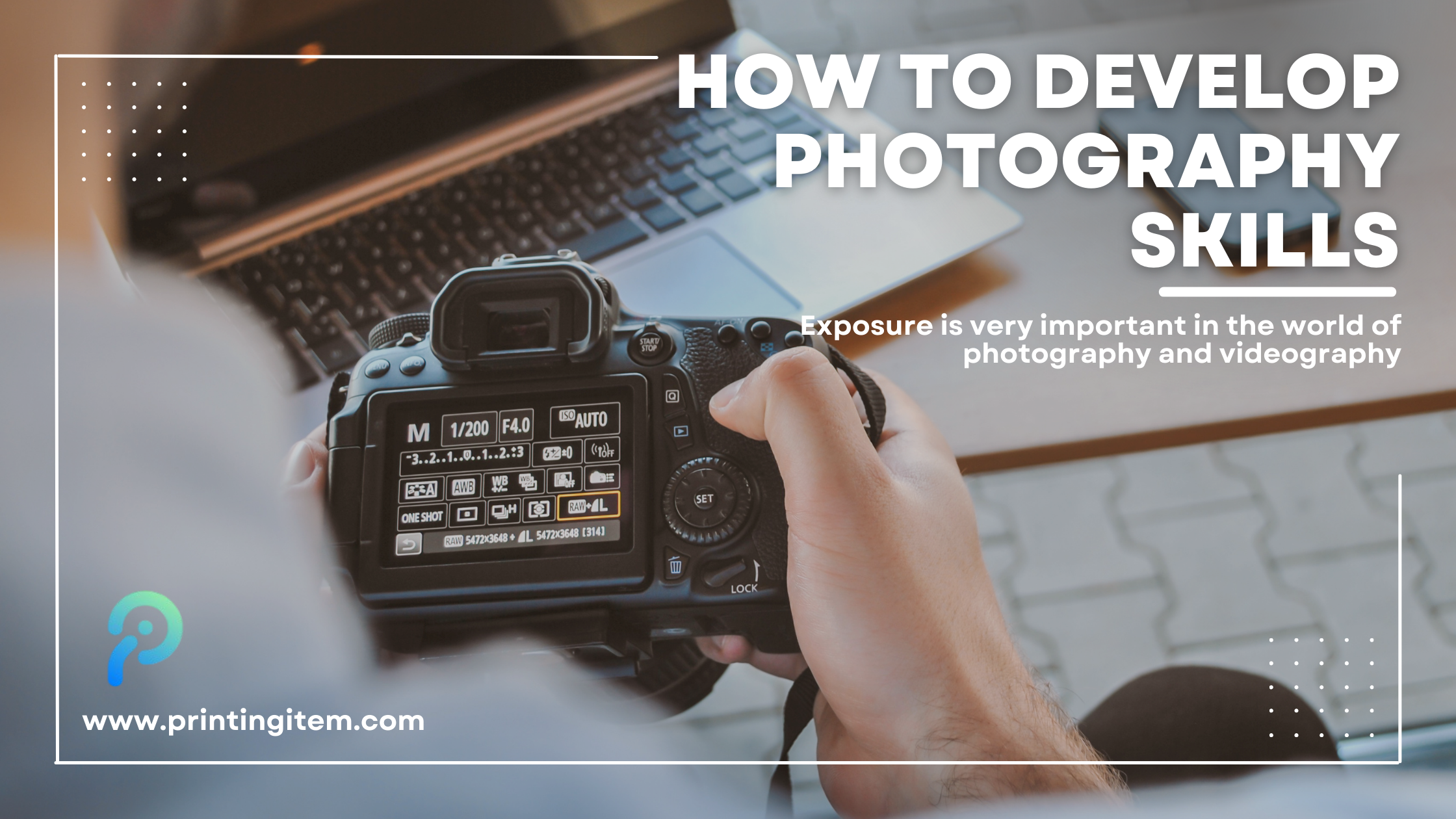
Photography is not a hobby, it is a strong medium of self-expression, while at the same time, it is a business need and a fast-developing profession. As a profession, photography could be greatly fulfilling and may pay well. If one is a novice or wants to rise in his photography skills, then professional photography requires hard work, practice, and learning. We talk in this book about how to turn your photography talent into a business: from mastering the technical part until getting a thriving photography business.
1. Understand the Basics of Photography
You need to understand the basics before taking up professional photography. A strong foundation is very important for proceeding in the journey of photography.
1.1 The Exposure Triangle
There are three fundamental settings to the exposure triangle, which define how light interacts with your camera's sensor.
The larger the aperture, or the smaller an f-stop number, the shallower a depth of field there will be. Conversely, a small aperture or large f-stop number means a greater depth of field.
Shutter Speed: The length of time that the camera's sensor is exposed to light. Faster shutter speed freezes motion; slow shutter speed will either provide motion blur or collect low-light scenes.
ISO: The camera sensor's sensitivity to light. Higher ISOs will let you take photos in lower light, but you will get noise or grain in your photographs.
It's the exposure triangle that allows you to control the quality and mood of your photographs.
1.2 Understanding Composition
Composition refers to the arrangement of things in your photo. It's one of the most fundamental photography skills since it might affect the story your image will tell in a big way.
Rule of Thirds: Place interesting things on or near grid lines or intersections when the picture is divided into a 3x3 grid.
Leading Lines: Exploiting natural lines, such as roads, rivers, or architectural elements, that carry the viewer's eyes to the point of focus.
Framing: Using objects or elements within the scene to frame your subject, creating a sense of depth and focus.
Symmetry: Balance your photos by placing elements in symmetry.
Negative Space: The space between, around, and sometimes within your subject. It creates a sense of simplicity and focus.
1.3 Lighting Techniques
Lighting is the most important part of photography and can drastically change the mood, texture, and details in your picture. The following types of lighting must be known:
Natural Light: Light from the sun. Experiment with the times of day (for example, golden hour or blue hour) to learn how to work with this light for the best results.
Artificial Light: The man-made light, such as flash, softboxes, studio lights. It can be very dramatic once you understand how to control this type of light.
Diffused Light vs. Direct Light: Where light is diffused through clouds, for example, it softens shadows; direct light casts sharp contrasts.
1.4 Camera Equipment
While the photographer's skill is in the foreground, knowing your camera gear is a must. A professional has to know how to handle equipment to its full potential. Very common equipment owned and operated by professional photographers includes:
DSLR or Mirrorless Camera: These are the industry-standard cameras for professionals, allowing the use of interchangeable lenses and more complex settings.
Lenses: There are numerous lenses of various focal lengths and apertures. Wide-angle lenses are good for landscapes, while telephoto lenses are better suited for wildlife or portraiture.
Tripods: For long exposures, landscape shots, and general stabilization.
External Flash: When you are shooting in low-light conditions or want an extra light to supplement your natural light.
Filters: Those placed in front of the lens of a camera to change the light that reaches it most commonly polarizers (to stop glare) or ND filters (to control exposure under bright light).
2. Building New Skills
Now that you've learned the basics, it's time to work on honing the craft and developing advanced skills, the type of skills that are going to separate you from everybody else as a professional photographer.
2.1 Mastering Post-Processing
Photo editing forms the backbone of photography today. Most professional photographers usually rely on photo editing software to enhance their photos. Among these are:
Global Adjustments: This includes exposure, white balance, and color correction in Adobe Lightroom.
Adobe Photoshop: For more detailed editing involving retouching, compositing, and advanced color manipulation.
Capture One: The vastly powerful raw processing tools make it the choice for professionals in photography.
You need to learn how to edit your images correctly and not overdo it. Post-processing allows exposure correction, revealing details in the highlights, and makes sure that your photographs conform with your creative vision.
2.2 Specializing in a Niche
In fact, professional photographers tend to specialize in one or more types of photographs. This helps not only in building expertise but also in establishing your identity in the marketplace. Some popular niches include:
Portrait photography: This is photography that focuses on capturing the personality and character of individuals. This can include a headshot, family portraits, or senior photos.
Event Photography: Covering events like weddings, parties, corporate functions, and concerts.
Commercial Photography: Photos taken for advertising and promotion. One of the genres of photography is product, food, and fashion photography.
Travel Photography: Pictures of landscapes, cultures, and people from all around the world. Wildlife and Nature Photography: Mostly featuring animals and natural landscapes, which usually requires patience and some specialized knowledge of the environment. Architecture Photography: Specializing in photographing buildings, interior and exterior structures.
2.3 Learn and Experiment Continuously The field of photography is dynamic, with new techniques, trends, and technologies always emerging. You will need to have the willingness to continue learning in:
Attend Workshops and Classes: Join photography workshops, online classes, and seminars to enhance your skill and learn new techniques. Keep updated with industry trends: Follow photography blogs, social media influencers, and online forums to be updated on what is happening in the field. Experiment: Don't be afraid to try new lighting setups, compositions, or editing styles. Innovation is what's going to make you different from other people in the field.
2.4 Building a Portfolio
A professional portfolio is required to attract clients and to showcase your work. Your portfolio should highlight your talents, creative ability, and versatility. Some tips to keep in mind while building a strong portfolio include:
Showcase Your Best Work: Choose only the strongest images that best represent your style and niche.
Diversify: Although you may be specialized in one genre, it's nice to have a mix of images that prove you're able to be versatile regarding the situation. Keep it updated: Your skills are going to change over time, so update your portfolio regularly to reflect your current level of expertise.
3. Building a Photography Business
Knowing photography is only half the battle; you need to develop a viable business to make it as a pro. Here's how:
3.1 Marketing Your Photography Business Marketing plays a very important role in attracting clients and extending the business. Here are some ways to market your photography business: Create a website: Having a professional website with a portfolio, contact details, and a blog makes it easier to prove your worth and brings in clients with ease. Social Media Marketing: Create an Instagram, Facebook, and Pinterest page to showcase your work and get in touch with potential clients. Instagram in particular is very strong for photographers. SEO Optimization: Ensure the site and all social media profiles are optimized for search engines. This includes using the right keywords in your website SEO ranking. Networking: Going to photography events, being in contact with other creatives, and reaching potential clients through networking.
3.2 Pricing and Contracts Keep the prices for your services appropriate to ensure that you are earning profits. Look around in your city for competitors and find a pricing structure that reflects the value of the work. It is also very important to draft contracts that protect both you and your clients; make sure the contract includes details with regard to the terms of payment, usage rights, and all other needed details.
3.3 Customer Service In this competitive world of photography, excellent customer service can really make all the difference. Building good relations with clients through clear communication, professionalism, and timeliness in delivery of images will bring repeat business and referrals. Creating a Brand Identity
3.4 As a photographer, you are a brand; so, create a brand identity to express your style, what you represent: logo, color palette, web design, and how you communicate with clients. Consistency in branding really makes clients easily recognize and trust you.
3.5 Organising Finances The most critical aspect that can determine the success of your photography business is managing your finances. Record every expense, from money invested in equipment to software subscriptions and marketing. Never forget taxes: be sure to save some of your earnings for tax purposes. Consider consulting with an accountant to better manage your finances.
Conclusion
To turn your photography skills into a profession, you would have to master a mix of technical competence, creativity, business acumen, and marketing savvy. Once you have mastered the basic principles of exposure, composition, and light; advanced in the areas of post-processing and genres of photography; and built a solid foundation for a photography business, you would be well-equipped to start building a successful photography career. But most importantly, becoming a professional photographer is continuing learning. Always keep the passion, and practice frequently. Do not say no to new opportunities that come knocking on the door. With this dedication and the right approach, you can build a thriving career in this exciting world called photography.






































